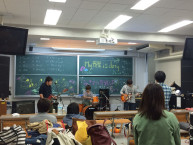Sodefure is a “Kyoto-style dance” which incorporates a variety of traditional Japanese dance styles and imagery into its routine. SOIC is one branch of a large Sodefure Community which has participating circles across a number of university campuses in Kyoto. Each group must learn the primary dance for Sodefure as these individual groups will come together and dance as a single group at festivals held in Kyoto. The largest of these events has over 1000 members dancing at once, the result of which is a beautiful and uniquely synchronized performance that is truly amazing to watch.
One of the particularly unique qualities of the SOIC Circle is that it is primarily directed towards international students. This means that I got to interact with a variety of students from around the world who were studying abroad in Kyoto. Naturally, there were also experienced Japanese Sodefure members present to help guide, teach, and interact with the international students.
What I ended up learning the most from by participating in this circle was not from the dance practice itself, but from watching the Japanese students interact with the foreign students. There was an incredible range in Japanese language ability among the study abroad students, and the Japanese students were not fluent in English. However, this didn’t deter anyone in the least from trying to build friendships across the language barriers. Members who were more proficient in Japanese helped out other students who were beginners, and we worked to teach the Japanese students new words in English. When all else failed, we simply pulled our cell phone dictionaries or tried our best to mime what we wanted to convey.
The most fascinating aspect to me was the casual atmosphere that arose incredibly quickly. Japanese students often started addressing new foreign students in the polite form (think desu/-masu), but soon relaxed to using casual speech and their home dialects within the span of one practice. The keigo and kouhai/senpai relationships which are so ubiquitous throughout Japanese-only circles was seemingly non-existent. The formal phrases I had practiced before going to the first meetup turned out to be unnecessary. People tended towards using first names instead of last ones, and due to the lack of formalities, it was difficult to tell who the leader was, or if there even was one at all. When the Japanese students gave me my own nickname to be used within the group, I fully came to understand how much they wanted to break down any walls of formality, and I started to feel really accepted into the group. I think that being part of a group that was directed towards foreigners allowed Japanese students to drop formalities more quickly than they can in other situations.
Being able to watch this dynamic and participate in it myself made me realize just how eager and willing people are to make international friends. In Japan, where many of the social interactions can be formal, even to the point of being outright cold, it was fascinating to watch how warm and open the Japanese students were when trying to break down the barriers between themselves and the foreign students. Having the opportunity to become part of such a large community has been an invaluable experience for me.



